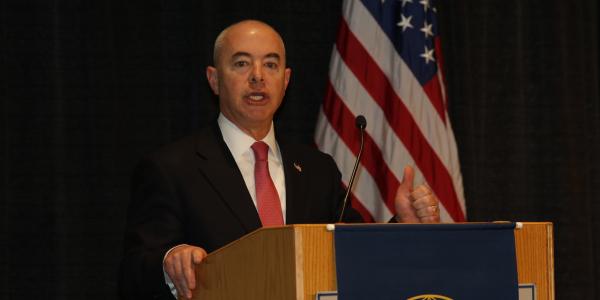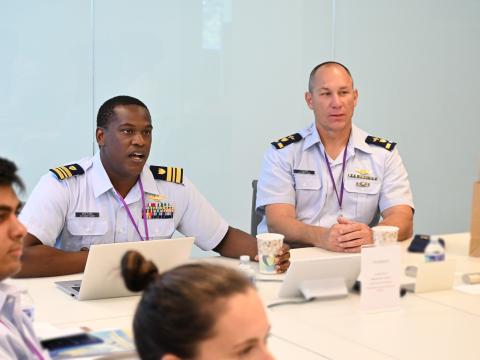DHS Seeks Industry Help to Secure the Nation, from Cyber to Biosurveillance
Cybersecurity is one of the critical homeland security priorities, along with the threats posed in the varying domains of aviation, border security and maritime, said the deputy secretary of the Department of Homeland Security.
Cybersecurity is one of the critical homeland security priorities, along with the threats posed in the varying domains of aviation, border security and maritime, said Alejandro Mayorkas, deputy secretary of the Department of Homeland Security (DHS). On top of those concerns, add unrest from around the world that poses a threat to national security. As such, securing the nation means the U.S. government simply cannot do it alone.
Enter private industry to the homeland security stage, Mayorkas said Tuesday during the Homeland Security Conference in Washington, D.C.
“One thing we need to do better to really advance unity of effort with industry is … openness and transparency,” he told the assembled attendees.
An “explosive growth in the area of cybersecurity” and numerous breaches in recent history, such as the attack on Sony Pictures Entertainment, helped bring the issue to the general public’s attention. Though unfortunate, breaches helped the nation’s “footprint on cybersecurity become clearer and stronger,” Mayorkas stated at the first day of the two-day conference.
The government is in pursuit of technologies to mitigate attacks as much as private partners, he stated. “We want to move from Flintstones to the Jetsons, move from a prehistoric architecture to the visionary,” Mayorkas told the attendees. “Our dollars are just as capable of attaining advances as dollar in the private sector.”
Day one featured seven panels of experts who addressed issues ranging from how small businesses can do business with the government to mitigating cyberthreats, information sharing, biosurveillance, emergency management, the emergence of the Internet of Things and a dedicated broadband network designated for first responders.
Government dollars might be as good as commercial partners, but the government is not dedicating nearly as much to research and development, as industry outspends the government 2-to-1. “Innovation occurs at the intersection of creativity and courage,” stated Doug Rand, assistant director of entrepreneurship in the White House’s Office of Science and Technology Policy.
More innovation happens when employees are encouraged to be creative and are not constrained by a cumbersome bureaucratic process—one reason Chris Darby, president and CEO of In-Q-Tel, said companies sometimes opt not to do business with the government.
The government acquisition process needs serious reform as the process takes too long and slow payments, along with slow acquisition decisions, make progress difficult for some companies. For small businesses looking to court government contracts, Debbie Deininger, president and CEO of Synkera Technology Incorporated, suggested they develop capabilities to fit the mission needs; for agencies wanting to entice small businesses, she suggested letting “the creativity of the contractor come out. It will lead to more diverse selection.”
However, the government can be good at innovation in certain areas, offered Darby. But he would not ask the government to build an iPhone: “You might end up with something the size of a Prius and cost $2 million,” he quipped. By the same token, he might not rely on Apple to build a battleship for the same reason.
Both the government and industry seek a balance between sharing cyberthreat details with each other and with federal agencies and protecting proprietary information, but panel experts agreed that more sharing must take place.
However, too much focus on implementing ways for information sharing alone misses the key fact that the tactic should not be the endgame. Instead, the sharing should be viewed as nothing more than an additional tool to get better situational awareness to make informed cyberthreat decisions, Bob Dix, vice president of Global Government Affairs and Public Policy at Juniper Networks, said.
The government plays a role in aiding private companies to find solutions to mitigate cybersecurity threats, but the role should be limited and focused, cautioned Rich Struse, chief advanced technology officer for the DHS.
The panel on biosurveillance spoke of a national strategy to focus early attention on pandemics and epidemics, even if the initial problems erupt miles from U.S. borders. The Ebola crisis that decimated some West African nations wasn’t deemed a U.S. problem until it was too late—when the crisis infiltrated U.S. boundaries, offered Cmdr. Franca Jones, USN, director of medical programs for the Office of the Assistant Secretary of Defense for Nuclear, Chemical and Biological Defense Programs. “Any country that can’t do its own biosurveillance will affect us,” Cmdr. Jones said.
Varying agencies of the federal system respond to different aspects of biosurveillance, with the DHS serving as the integrator and clearinghouse of information for the entire nation.
On a different tract, experts warned of the rise of the Internet of Things phenomenon, predicted to garner $8 billion by 2020.
The explosion prompted even the U.S. Congress to seek speedy innovations to keep hackers from exploiting, tampering, spoofing or stealing information and identities from the growing number of gadget users all connected to the Internet.
Technological advances have led to such rapid systems communicating either machine-to-machine or human-to-machine that it can respond faster than humans can intervene.
Finally, though slow to reach fruition, the FirstNet endeavor, an independent authority tasked with building a first-ever, nationwide wireless broadband network for public safety, has made significant progress, said T.J. Kennedy, the program’s executive director. Through the federal sale of spectrum, the effort is building its endeavor on a $7 billion budget, which will allocate 20MHz of dedicated bandwidth in the prime upper 700 MHz frequency range.
Created in 2012 by Congress and part of the National Telecommunications and Information Administration, FirstNet needs to tap private industry capabilities to building and manage the network. It plans for a terrestrial LTE network to cover areas of the United States and offer state-of-the-art, ruggedized communications for firefighters, police and medical responders serviced through mobile communications and satellite systems.
"We see this as transformational," said Doug Robinson, executive director of the National Association of State Chief Information Officers. "This is going to change the game."





Comments